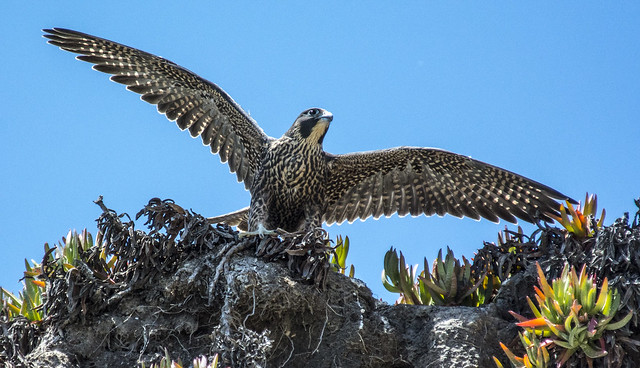 |
| Peregrine Falcon, (Red-capped Falcon) (Photo credit: Wikipedia) |
Falcons are amazing predators and in my opinion the most spectacular aerial predator in the world. They are not the strongest amongst birds of prey, but their hunting tactics are truly remarkable. There is a reason that fighter jets are designed after falcons. It is not just the amazing speed, but also the way they are able to turn at g-forces that would kill a human being.
There are many types of falcons throughout the world and North America. The most commonly found in North America are the Prairie Falcon, American Kestrel, Merlin, Gyr Falcon, and the infamous Peregrine Falcon. Kestrels hunt in a different fashion and do not use diving techniques. The Peregrine is the most well known for its speed and hunting ability. In my opinion, the Gyrfalcon, although larger is as fast as the peregrine.
Falcons mainly prey upon other birds, such as ducks, pigeons, grouse, etc... They fly high in the sky far above their prey and when ready to pursue, go into an incredible dive. In the dive, they turn in a corkscrew fashion after their prey. Even though the fastest way from one point to the other is a straight line, the falcon dives in this way to keep its eye on its prey. The reason is their eyes are placed more on the side of their head, instead of looking straight forward like humans. They have long narrow wings built for speed and a long narrow tail built for amazing turning capability. They strike their prey at incredible speeds in mid-air, sometimes the one strike is all it takes to kill. If not the falcon will gain altitude again quickly and strike again and again. They are also well known for chasing their prey down after the initial strike. They sometimes hit with their feet and talons open and sometimes with their feet closed making a fist. Either way is enough to make a lethal blow to its prey.
The Peregrine Falcon has been documented diving at speeds at 232mph. This 2-pound bird has been known to take prey as large as a 9-pound sage grouse, the largest game bird in North America. In the falconry world, falconers breed falcons for hunting purposes. The popular Falcon to breed is a hybrid, a bird that is half peregrine and half Gyrfalcon. Many falconers like to use male birds because of their tenacity, the problem is the males are smaller than females and are not large enough to take down the popular sage grouse. This hybrid bird is perfect for sage grouse hunting, they get the large size from the Gyrfalcon and the tenacity from the peregrine falcon. These hybrids are usually the size of a female peregrine but have the personality of a male.
The peregrine falcon seemed to be doomed to extinction because of a chemical pesticide, called DDT that farmers used on their crops. Finally, the US banned DDT and since then the peregrine, along with many other species of birds have made a full recovery. The peregrine is common and will even build their nests on ledges of a giant building that resemble a cliff in big cities. Watch high in the sky for this amazing predator that is truly the jet fighter of the bird world.
|

